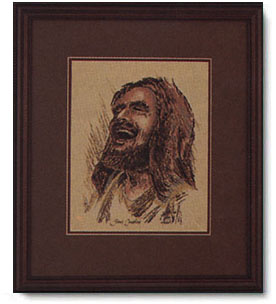There is no undisputed historical
depiction of Jesus.
The most common illustration are
Christian icons. Images flourished in
Medieval art. Most surviving images of Jesus have in common a number of appearance traits which are now almost universally associated with Jesus despite lack of evidence for the accuracy of these depictions.
No detailed physical description of Jesus is contained in any of the
canonical Gospels. During the
Roman Empire's
persecution of Christians, Christian art was necessarily furtive and ambiguous. The earliest surviving Christian art comes from the late 3rd and early 4th centuries on the walls of
Christian tombs in the
catacombs. Here, and only here, Jesus is portrayed in two different ways: older, bearded and robed and another as a bare faced youth holding a wand. He uses the wand to
change water to wine,
multiply the bread and fishes, and raise
Lazarus. When pictured healing, he only
lays on hands. The wand is thought to be a symbol of power. The bare faced youth with the wand may indicate that the Jesus was thought of as a user of magic or a wonder worker by some
Early Christians.
There is also the
Shroud of Turin, which appears in history in
1353 and which some have speculated is the same image as the Mandylion of Edessa, which disappeared in the wars surrounding the fall of the
Byzantine Empire shortly before then. Controversy still surrounds the claims made for the Shroud of Turin.
There are also
icon compositions of Jesus and Mary that are traditionally believed by many
Orthodox to have originated in paintings by
Luke the Evangelist.
Christian depiction of Jesus Main article: Alexamenos graffito Alexamenos graffito Conventional depictions of Christ include:
Theotokos images (mother and child)
Baptism of the Lord Crucifixion Descent from the Cross Pieta (mother and dead son)
Resurrected Christ Lamb of God Christ Pantokrator Last Judgement Unconventional depictions Several
Hadith quote Muhammad describing
Isa (the Islamic name of Jesus) as he appeared in a dream, and during Muhammad's
ascension to Heaven:
"While I was sleeping, I saw myself (in a dream), performing Tawaf (circumambulation of the House of God in Makkah). I saw a
reddish-white man with lank hair, with water dripping from his head, I asked, "Who is this?" They replied, "The Son of Maryam (Mary)..." (
Bukhari,
Muslim)
"Narrated Abdullah: The Prophet mentioned...While sleeping near the Ka'ba last night, I saw in my dream a man of
brown color the best one can see amongst brown color and his hair was long that it fell between his shoulders. His hair was lank and water was dribbling from his head and he was placing his hands on the shoulders of two men while circumambulating the Kaba. I asked, 'Who is this?' They replied, 'This is Jesus, son of Mary.'" (Bukhari
4:55:649)
"Narrated Salim from his father: No, By Allah, the Prophet did not tell that Jesus was of
red complexion but said, "While I was asleep circumambulating the Ka'ba (in my dream), suddenly I saw a man of
brown complexion and lank hair walking between two men, and water was dropping from his head. I asked, 'Who is this?' The people said, 'He is the son of Mary.'" (Bukhari
4:55:650)
"Narrated Abu Huraira: Allah's Apostle said, "On the night of my Ascension to Heaven...I saw Jesus who was of
average height with red face as if he had just come out of a bathroom." (Bukhari
4:55:607)
Jesus in Islam Jesus as the
Good shepherd. Ceiling of S. Callisto catacomb, mid
3rd century.
A representation of Jesus as the sun-god
Helios/
Sol Invictus riding in his chariot. Mosaic of the
3rd century on the
Vatican grottoes under
St. Peter's Basilica.
Mural painting from the catacomb of Commodilla. One of the first bearded images of Jesus, late
4th century.
Depiction of Jesus in
St. Catherine's Monastery in
Sinai,
6th century.
An image of Jesus as a medieval knight bearing an attributed
coat of arms devised by
officers of arms based on the
Veil of Veronica Jesus depicted on an early
8th-century coin.
This
11th-century portrait is one of many images of Jesus in which a
halo with a
cross is used. Such depictions are characteristic of
Eastern Orthodox iconography. Characteristically, he is portrayed as similar in features and skin tone to the culture of the artist.
A 13th century
Byzantine mosaic of Christ from
Hagia Sophia,
Constantinople.
An traditional
Ethiopian depiction of Jesus and Mary with distinctively "Ethiopian" features.
The Baptism of Christ, by
Piero della Francesca,
1449.
Jesus, aged 12, teaching the doctors of the Faith, painted by
José Ribera.

A
Chinese depiction of Jesus and the rich man, from Mark chapter 10.
A mural depicting the baptism of Jesus in a typical Haitian rural scenery, Cathédrale de Sainte Trinité,
Port-au-Prince,
Haiti.
Sister Faustina's representation of
Jesus of Divine Mercy The Diving Mercy painting by Adolf Hyla (1943).The polish writing at the bottom means "Jesus I trust in you"
Sculpture Race of Jesus Iconography Salvator Mundi Christ the Redeemer (statue) Christ the Redeemer (icon) The Last Supper (Leonardo) Michelangelo's Pietà Crucifixion Holy card Perceptions of religious imagery in natural phenomena
 A
A
No comments:
Post a Comment